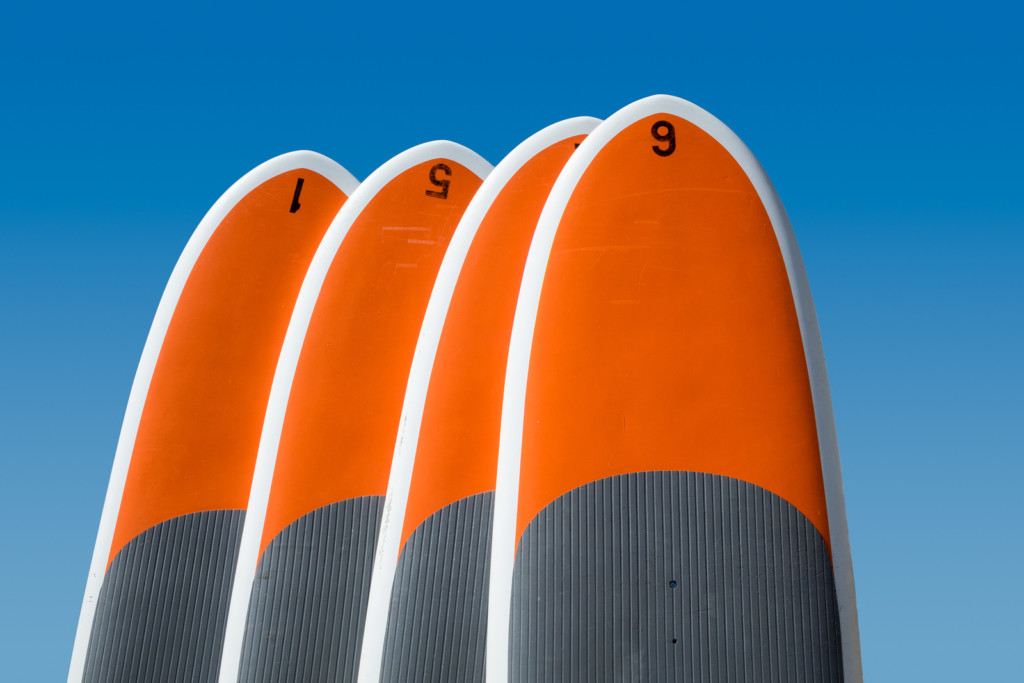SUP was first made popular by surfer Laird Hamilton. He used the paddle to help him catch the towing waves found in Hawaii. Popular among surf instructors and photographers trying to get a vantage point above the water’s surface, SUP has moved beyond surfing. Stand up paddling can be done in many venues such as on flat water protected lakes, simple beach paddling and open water paddling in addition to surfing waves.
Parts of a Stand Up Paddle Board
The stand up paddle board has evolved since its humble beginnings in surfing. Now SUP boards are designed specifically for the sport and have their own lingo.
Nose
Also called the front or tip, the nose is the front of the paddle board.
Tail
The back or rear 12” of an SUP is the tail and its design is very similar to that of a surfboard. A round tail will provide a smooth turn while edgy wide tails are used for aggressive turns.
Deck
The top part of a stand up paddle board which you stand on is called the deck. Their surface can be flat, curved or domed. Beginner boards may have contoured or recessed areas signifying where to stand.
Bottom
The bottom is simply called the bottom. While most are flat, convex in shape (curved inward) which make them faster and aids in maneuverability. They are also less stable.

Rails of an SUP
The sides or edges of the stand up paddle board are known as the rails. Domed-decked boards allow for smaller volume rails which helps the rider to rock from rail to rail while surfing. Higher volume rails make the board more stable. It is quite common for the rails on a SUP to get dinged up from the SUP paddle hitting it while paddling.
Rocker of an SUP
The rocker of a stand up paddle board refers to the curvature of the board from the nose to the tail (tip to tip) of the board. This makes more difference when surfing than it does when flatwater paddling.
Deck Pad of a Stand up Paddle board
The deck pad of a stand up paddle board refers to the foam, rubber, or other surface that is placed on the board to provide traction, paddling, and style. Of course traditionally surfers use wax on their boards to provide the traction they need. On stand up paddle boards, however, paddlers are standing up a whole lot longer making the cushion of the deck pad a welcome addition as people learning to SUP will readily attest.
Fins and Fin Box
Just like on surfboards, stand up paddle boards have fins on the bottom tail of the board. Fins help the board from sliding out while surfing and help in “tracking” straight on flat water. Included in this is that they aid the stability of the board. A board can have one, two, or three fins. The hole that the fins bolt into is known as a fin box.
Handle of a Stand up Paddle board
It’s difficult to imagine just how wide and long stand up paddle boards are until you’re standing in front of one. They’re not like surfboards that you can just sling under your arm and run off to the beach. For this reason manufacturers have molded-in oval or groove in the board so you can put your hand into it when the board is under your arm. This is also sometimes called a soap dish.

Leash and Leash Cup of a SUP
Just as in surfing the SUP leash attaches the rider’s ankle to the rear of the paddle board. A leash cup is a little plastic piece in the deck of the tail of the board where the leash attaches.
Vent and Vent Plug
Some stand up paddle boards have vents that are sealed with vent plugs. Since the boards are made of foam the gases contained in the board will expand and contract with the air temperature. Vent plugs can be removed to allow the gases to equalize during storage and to prevent damage to the board due to over expansion of the gases.
Ready to Give Stand Up Paddle Boarding a Try?
Knowing the different parts of a stand up paddle and how different styles affect the board’s handling and stability can aid you in making an informed decision when choosing an SUP. As a beginner, it may be best to start with a more stable board and try other types of boards as your skill level progresses. Beginner paddlers often rent an SUP or purchase a used one until they become more comfortable in their paddling abilities.
Since 1989, Acme Beach and Bike has helped 1000’s of folks to have fun on LBI. We rent and sell stand up paddle boards and can help you choose the right SUP for you. Come see us at our bay beach @ Bayview Park on 68th St in Brant Beach to demo each and every board until you find the right one.


